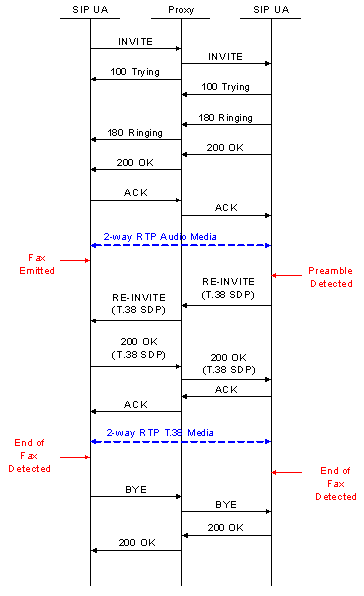
You are here: CSP Developer’s Guide: Internet Protocol > 5 Session-Initiation Protocol (SIP) Software > SIP Signaling Support for T.38 Fax Media Sessions (for Non-Call Agent Mode)
SIP Signaling Support for T.38 Fax Media Sessions
(for Non-Call Agent Mode)
The Session Initiation Protocol (SIP) is a signaling protocol used for establishing sessions in an IP network. A session can be a simple two-way telephone call or a collaborative multi-media conference session. SIP uses Session Description Protocol (SDP) to convey and negotiate media session information.
Prior to this feature, the CSP signaling stack establishes only audio media sessions. This feature enhances the SIP and SDP stacks to allow the existing CSP media resources to originate and terminate T.38 fax media sessions. The CSP can now:
• Signal T.38 fax parameters using the network
• Control of local DSP resources to start a T.38 fax session
The CSP SIP signaling state machine can initiate a switchover from audio to T.38 fax or Pass-Through image sessions.
• A session starts with audio capabilities, and upon fax tone detection, the T.38 fax capabilities are negotiated.
• Upon successful negotiation, the session continues with the fax capabilities. The media termination hosts exchange T.38 Internet fax packets.
SIP allows the type and properties of a media session to be changed in the middle of a media session. In SIP this capability is a "re-INVITE". All session modifications to and from the T.38 fax media will be accomplished using re-INVITEs.
The CSP supports the fax pass-through mode. In this mode, the facsimile communication is handled as a PCM audio call (PCMA/PCMU as specified in ITU-T recommendation G.711). The fax pass-through mode is important to support interoperability with SIP communication peers that do not support T.38 fax.
The bypass audio connection has the following characteristics:
• PCM G.711 codec
• Silence suppression OFF
• Echo cancellation ON
Pertinent Specifications
• ITU-T Recommendation T.38
• ITU-T Recommendation T.38 Annex D
Benefits to Customer
This feature provides the following benefits to the customer:
• Ease in initiating a T.38 fax session
• Enables the CSP to automatically switch between audio and imaging (fax)
API Messages
• Outseize Control (0x002C)
• Route Control (0x00E8)
• Table Download (0x00D6)
SIP T.38 and Fax Pass-Through Call Flows
Normal SIP T.38 Call Flow
The call flow below shows a typical T.38 fax call between two SIP User Agents (UAs) and an intermediary proxy. The call begins with an audio media session and then switches over to T.38 fax.

Fax Pass-Through Call Flow
The call flow below shows a typical fax pass-through scenario between two SIP UAs and an intermediary proxy. The call begins with an audio media session and then switches over to an audio connection.
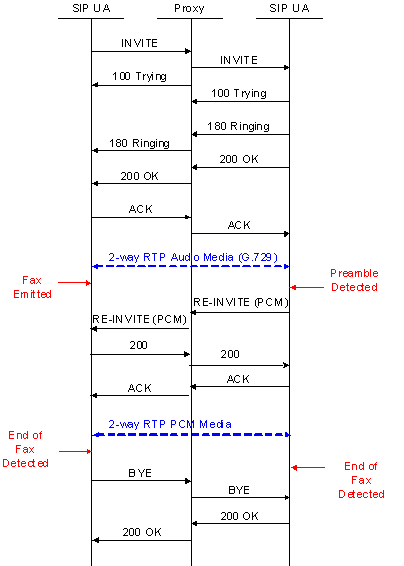
Detailed Description
The CSP supports both T.38 fax and Pass-Through (also known as bypass) as two independent modes of fax transmission but Dialogic does not recommend running both modes on the same IPN-2 card.
Either mode is configurable in the CSP on a per Layer 4 (L4)-Router Resource Group basis.
The host application controls the fax mode for outbound calls on a per call basis. This control is done through populating the NPDI SIP Fax Mode (0x27AF) TLV in the Route Control (0x00E8) or Outseize Control (0x002C) messages. The NPDI SIP Fax Mode (0x27AF) TLV is also supported in the L4-Router Resource Group by using the PPL Table Download (0x00D6) message.
CSP Channel Call Setup
For inbound calls, the fax type is extracted from the L4 Call Control PPL Information-Router.
For outbound calls, the fax type is extracted from the L4-Router if the host application issues a Route Control (0x00E8) message and does not include the NPDI SIP Fax Mode (0x27AF) TLV.
If the host application issues an Outseize Control (0x002C) message, the NPDI SIP Fax Mode (0x27AF) TLV must be included in the message if a fax session is desired. Once the fax type is provided to the DSP (even the session is only audio at this point in time), it cannot be changed in the middle of the call.
The L4-Router stores the NPDI SIP Fax Mode (0x27AF) TLV on a per resource group basis. This TLV is used for inbound SIP calls and, if not overridden by the host, it can be used for outbound SIP calls.
Audio to Fax Switchover
The CSP sends and receives fax media only after a switchover from audio media. A session must always begin as an audio session and then it will switch over to a fax session if in-band fax tones are detected.
Once a session switches over from audio to fax, the CSP does not support any subsequent modifications of the session. For instance, the session can not be switched back to audio once it has made the switchover to fax.
Media Gateway (IP/TDM) and/or a SIP B2BUA (IP/IP)
The CSP can be used as a Media Gateway (IP/TDM) and/or a SIP B2BUA (IP/IP) based on this feature. In the SIP B2BUA mode, the two UA contexts within CSP do not propagate fax events (such as re-INVITEs) between each other. Instead, the end-to-end in-band tones trigger the underlying T.30 engines to drive the session from audio to fax independently for each UA context.
Transparent Mode
The CSP does not support a mode where fax tone detection can be completely disabled in the DSPs. From a signaling perspective, the CSP supports disabling the fax mode. This is "transparent mode."
The transparent mode works as follows: The packetization DSPs do not report any fax events to the signaling stacks, but they internally detect non-audio transmissions and automatically try to disable silence suppression, echo cancellation etc. for the session.
In-Band Fax Tones
The CSP will react to in-band fax tones on its own without host intervention. The host has overall control through configuration and even on a per call basis for outbound calls. However, in the interest of meeting timing constraints in negotiating fax sessions, the audio to image switchover process will be completely handled within the CSP. The CSP continues to generate PPL event indications for inbound re-INVITEs. Outbound re-INVITEs that are triggered by the IPN-2 DSPs are not indicated to the host.
The CSP reacts to in-band fax tones regardless of the direction in which the session was setup (inbound or outbound). Since the CSP reacts to in-band fax tones by sending re-INVITEs, the lack of sense of call setup direction almost always causes re-INVITE glare. The CSP handles re-INVITE glare. It handles the re-INVITE race based on a first come first served basis. If the CSP SIP signaling stack receives the fax started event from the underlying DSP first, then it initiates a re-INVITE. This re-INVITE will be an atomic operation in the CSP, which means that the CSP automatically accepts nothing but a response to the re-INVITE at this point. Any intermediary events are queued up for later processing.
Glare Effect
A fax transmission can be detected by the receiving side, the emitting side or both. For the emitting side, a 'glare' effect may appear. The CSP SIP stack state machine is designed to not introduce glare and to handle glare introduced by the other party. The CSP SIP stack ignores the L3_L3Pn_FAX_START indication from the DSP if it arrives after a SIP re-INVITE (T.38 fax or bypass) has been received. If the CSP sends a SIP re-INVITE and receives a re-INVITE glare from the other party and if the two do not crossover on the wire than both the transactions will complete independent of each other. The IPN-2 DSP receives two back-to-back Resource Attribute Configure messages in this case.
No Fallback Mode
If the remote SIP gateway or endpoint does not support Fax T.38, the CSP does not fallback to Fax G711. Depending on the CSP’s configuration, the CSP will transmit either Fax T.38 or ByPass only.
Configuring and Querying with API
Configuring
Enabled by setting the SIP Stack T.38 Fax Support (0x011C) TLV in the VoIP Protocol Configure (0x00EE) message.
Querying
The host can query this feature by querying the SIP Stack T.38 Fax Support (0x011C) TLV in the VoIP Protocol Query (0x00EF) message.
Configuring with CSA
Refer to Configuring SIP in the Converged Services Administrator User’s Guide to configure with SwitchKit CSA.
Call Flows
The T.38 fax call flow scenarios, include the following aspects of the call sequence:
• Detection of the fax transmission
• Usage of the T.38 session description attributes
• Session termination
Scenario 1: CSP is the terminating gateway and sends a T.38 fax re-INVITE
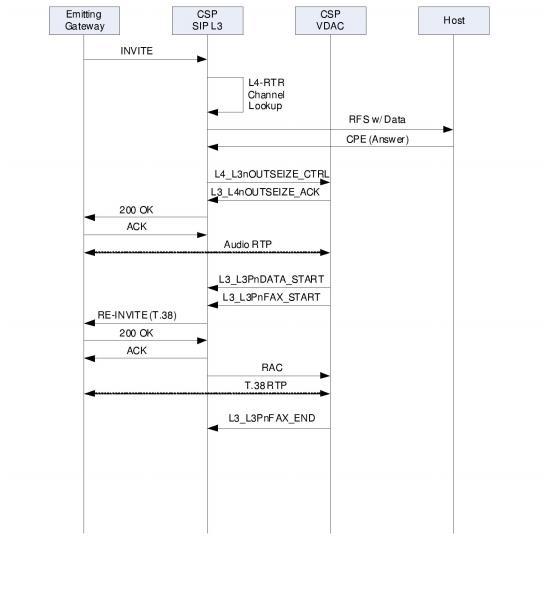
Scenario 2: CSP is the terminating gateway and receives a T.38 fax re-INVITE
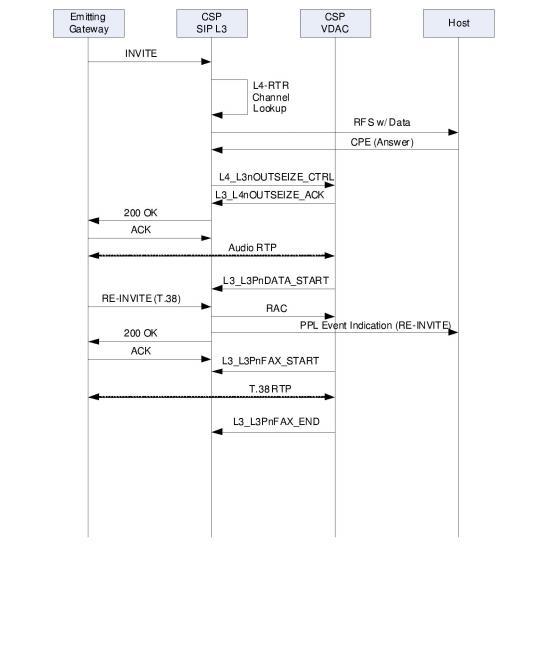
Scenario 3: CSP is the originating gateway and sends the T.38 fax re-INVITE
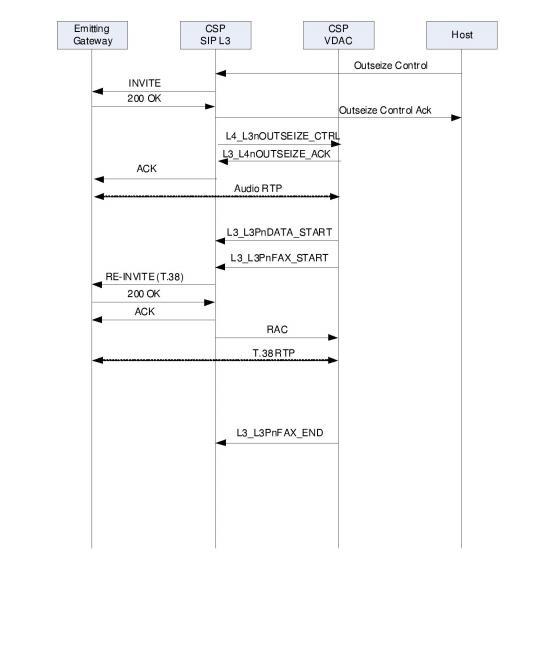
Scenario 4: CSP is the originating gateway and receives the T.38 fax re-INVITE
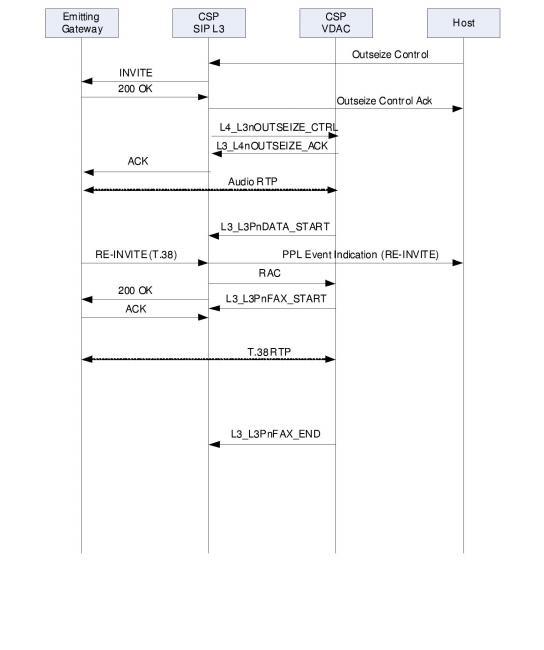
Scenario 5: CSP is the terminating gateway and sends a Bypass fax re-INVITE
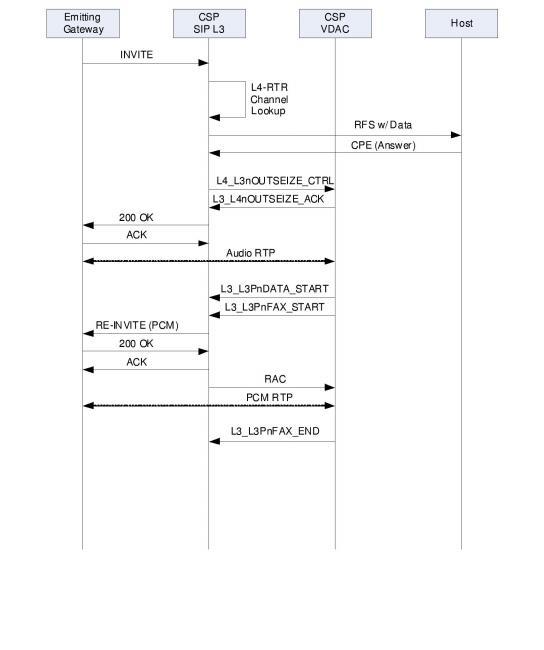
Scenario 6: CSP is the terminating gateway and receives a PCM fax re-INVITE
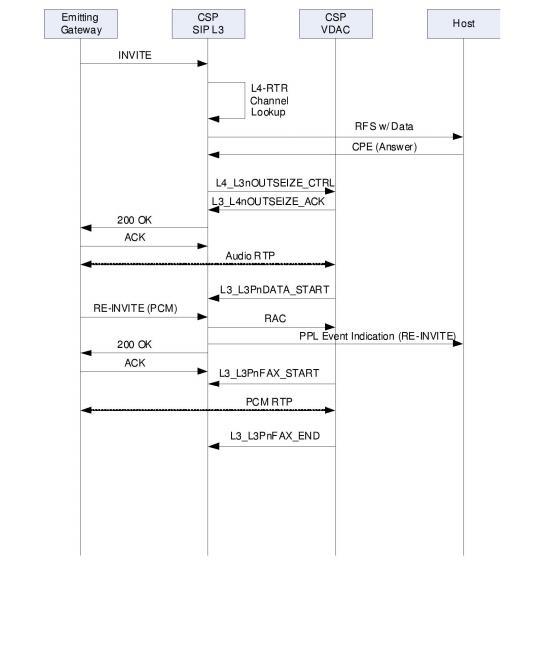
Scenario 7: CSP is the originating gateway and sends the PCM fax re-INVITE
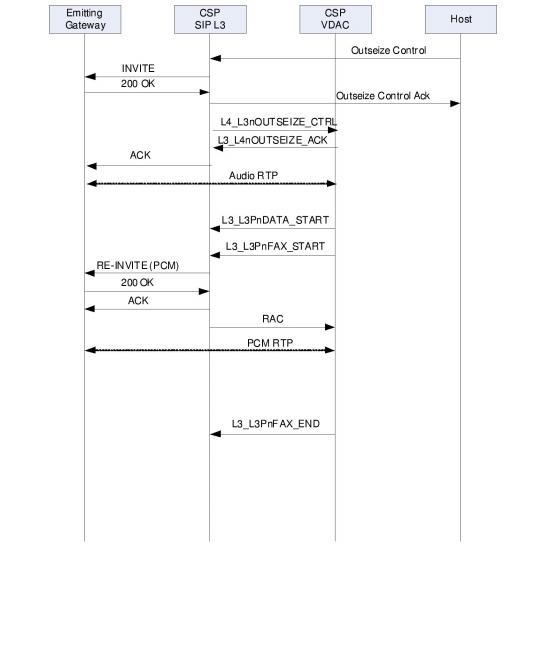
Scenario 8: CSP is the originating gateway and receives the PCM fax re-INVITE
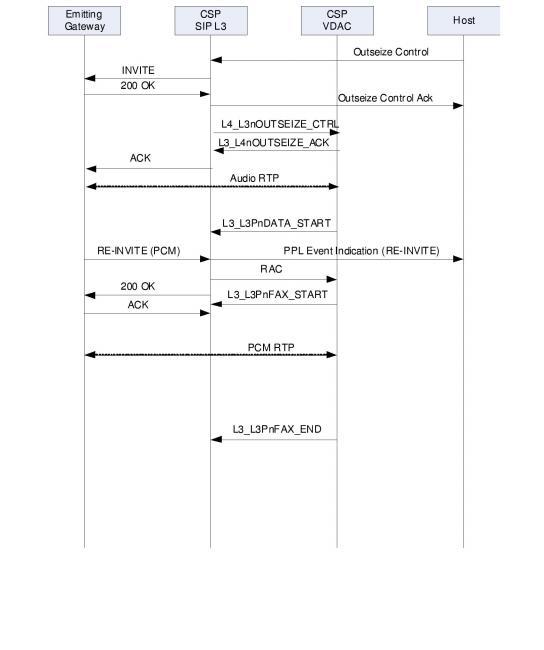
API Message Changes
This feature results in changes to the following API messages:
VoIP Protocol Configure (0x00EE)
VoIP Protocol Query (0x00EF)
The 0x011C TLV is added to both messages.
Important! This TLV is mandatory for enabling T.38 fax capability on the CSP.
|
: |
TLVs Mandatory 0x011C SIP Stack T.38 Fax Support |
||
The optional 0x27AF TLV is added to this message.
Important! This TLV is optional for fax calls when using L4 managed route control.
SIP
Extended ICBs
0x0033 NPDI Universal ICB
0x27AF NPDI SIP Fax Mode TLV
Value: 0x00 Disable; 0x01 T.38 Fax; 0x02 Fax Bypass
Information Control Block (ICB) Change
This feature supports the following change to the 0x0033 NPDI Universal ICB in the Outseize Control (0x002C) message.
0x0033 NPDI Universal ICB
The TLV 0x27AF is added to this ICB.
Important! This TLV is mandatory for fax calls when using host managed Outseize Control and Route Control.
|
|
SIP 0x27AF NPDI SIP Fax Mod |
Tag Length Values (TLVs) (New)
This feature supports the following new TLVs.
0x011C SIP Stack T.38 Fax Support
Used in:
VoIP Protocol Configure (0x00EE)
VoIP Protocol Query (0x00EF)
|
Byte |
Description |
|
0,1 |
Tag 0x011C SIP Stack T.38 Fax Support |
|
2,3 |
Length 0x0001 |
|
4 |
Value[0] 00=Disabled 01=Enabled |
0x27AF NPDI SIP Fax Mode
Use this TLV in the following messages:
• Outseize Control (0x002C) and Route Control (0x00E8)
Host managed outseize control and route control. Use as a mandatory TLV in this message.
• PPL Table Download (0x00D6)
Use as a L4-Router TLV in this message.
• Route Control (0x00E8)
L4 managed route control. Use as an optional TLV in this message.
|
Byte |
Description |
|
0,1 |
Tag 0x27AF NPDI SIP Fax Mode |
|
2,3 |
Length 0x0001 |
|
4 |
Value[0] 00=Disabled 01= Initiate T.38 re-INVITE 02= Initiate Bypass (PCM) re-INVITE |